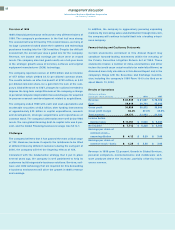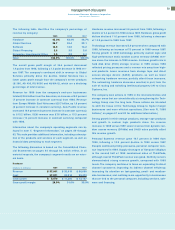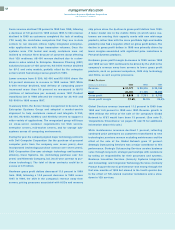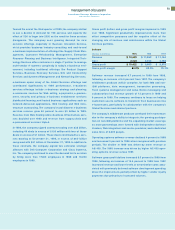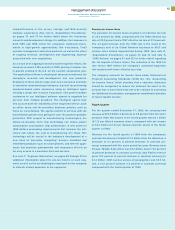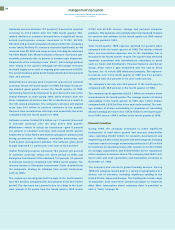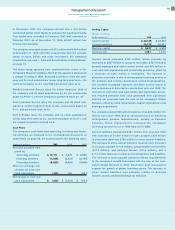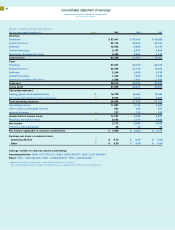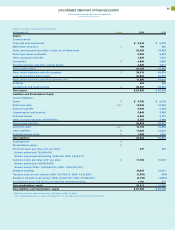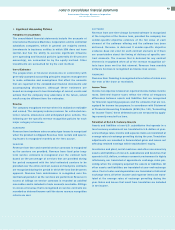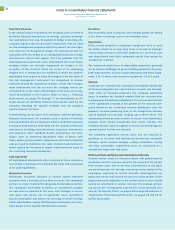IBM 1999 Annual Report Download - page 63
Download and view the complete annual report
Please find page 63 of the 1999 IBM annual report below. You can navigate through the pages in the report by either clicking on the pages listed below, or by using the keyword search tool below to find specific information within the annual report.
management discussion
International Business Machines Corporation
and Subsidiary Companies
Market Risk
In the normal course of business, the financial position of the
company routinely is subject to a variety of risks. In addition to
the market risk associated with interest rate and currency move-
ments on outstanding debt and non-U.S. dollar denominated
assets and liabilities, other examples of risk include collectibility
of accounts receivable and recoverability of residual values on
leased assets.
The company regularly assesses all of these risks and has
established policies and business practices to protect against
the adverse effects of these and other potential exposures. As
a result, the company does not anticipate any material losses
from these risks.
The company’s debt in support of the global financing business
and the geographic breadth of the company’s operations contain
an element of market risk from changes in interest and currency
rates. The company manages this risk, in part, through the
use of a variety of financial instruments including derivatives,
as explained in note L, “Financial Instruments,” on pages 75
through 77.
For purposes of specific risk analysis, the company uses
sensitivity analysis to determine the effects that market risk
exposures may have on the fair values of the company’s debt
and other financial instruments.
The financial instruments that are included in the sensitivity
analysis comprise all of the company’s cash and cash equiva-
lents, marketable securities, long-term non-lease receivables,
investments, long-term and short-term debt and all derivative
financial instruments. The company’s portfolio of derivative
financial instruments includes interest rate swaps, interest rate
options, foreign currency swaps, forward contracts and foreign
currency option contracts.
To perform sensitivity analysis, the company assesses the risk
of loss in fair values from the effect of hypothetical changes in
interest rates and foreign currency exchange rates on market
sensitive instruments. The market values for interest and foreign
currency exchange risk are computed based on the present
value of future cash flows as affected by the changes in rates
that are attributable to the market risk that is being measured.
The company selected the discount rates that it used for the
present value computations based on market interest and for-
eign currency exchange rates in effect at December 31, 1999 and
1998. The differences in this comparison are the hypothetical
gains or losses associated with each type of risk.
Information provided by the sensitivity analysis does not
necessarily represent the actual changes in fair value that the
company would incur under normal market conditions because,
due to practical limitations, all variables other than the specific
market risk factor are held constant. In addition, the results of
the model are constrained by the fact that certain items are
specifically excluded from the analysis, while the financial
instruments that relate to the financing or hedging of those
items are included by definition. Excluded items include leased
assets, forecasted foreign currency cash flows, and the com-
pany’s net investment in foreign operations. As a consequence,
the reported changes in the values of some financial instru-
ments that affect the results of the sensitivity analysis are not
matched with the offsetting changes in the values of the items
that those instruments are designed to finance or hedge.
The results of the sensitivity analysis at December 31, 1999,
and December 31, 1998, are as follows:
Interest Rate Risk: As of December 31, 1999, a 10 percent decrease
in the levels of interest rates with all other variables held constant
would result in a decrease in the fair value of the company’s
financial instruments of $164 million as compared with a
decrease of $322 million as of December 31, 1998. A 10 percent
increase in the levels of interest rates with all other variables
held constant would result in an increase in the fair value of the
company’s financial instruments of $145 million as compared
with an increase of $282 million as of December 31, 1998.
Changes in the relative sensitivity of the fair value of the com-
pany’s financial instrument portfolio for these theoretical
changes in the level of interest rates primarily are driven by
changes in the company’s debt maturity and interest rate pro-
file and amount. In 1999 versus 1998, the reported decline in
interest rate sensitivity primarily is due to the effect of increased
activity in receive fixed/ pay floating interest rate swaps.
61



